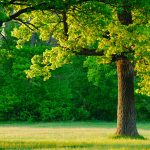Is Your Tree A Liability?
Do you have a tree on your property that has you wondering what would happen if it fell in a storm? What if it fell on your neighbor’s house? Would you have to pay for the damages? This question is asked a lot when wind storms are rolling in and out. Below we’ll discuss a few different situations and how to avoid the worst case scenario.
A healthy tree on your property falls and causes damage to your neighbor’s home.
In this case, your neighbor’s homeowner’s insurance policy would respond to damage and removal of debris. The critical part of this outcome (and that of all the cases we will cover below), however, is that the tree was perfectly healthy when it fell. If the tree is a hazard, it’s a whole other story.
Let’s say, for example, that a tree in your backyard is old and showing signs of decay or disease. Maybe it’s even starting to lean and has your neighbor worried. Then, let’s say that neighbor sends you a letter asking you to do something about the potential danger and documents your tree’s poor health. If you neglect to care for the tree and it winds up causing damage to your neighbor’s house, shed, pool, fence, or lawn, then you will be forced to pick up the tab.
This is tricky because insurance by it’s very definition is for the unknown. If you were to have a Certified Arborist inspect your tree and declare it a hazard, both you and your neighbor’s insurance companies would be notified. Therefore, it would become a known issue, which insurance companies will not cover.
Even if your tree is perfectly healthy, insurers will sometimes have a $1,000 limit on payouts for tree-related claims, which can really put homeowners in a bind when something happens. So, check with your insurance agent to find out what the limits are, then make changes if you feel it’s needed.
As a homeowner, it is your responsibility to keep your property clean and safe, and that means being proactive about tree care. It’s important to watch out for dead limbs or dead trees and have them removed.
Here are 15 Reasons to Remove A Tree.
Below are a few other possible scenarios involving trees and property damage. Assuming the tree was healthy prior to the incident, these are the most likely outcomes:
A tree on your property fell on your own detached garage and damaged the roof.
Standard home insurance policies typically cover detached structures. Restoration of your property and removal of the tree would be covered.
A tree fell on your property but caused no damage.
In most cases, home insurance would not provide coverage for the tree or the cost of removal, unless your policy has an endorsement specifying that coverage.
A tree fell on your car in your driveway.
Comprehensive car insurance would provide coverage. Comprehensive coverage is optional, and unlike liability insurance, it pays for damage to your own vehicle from causes other than car accidents, such as natural disasters, theft, and vandalism.
If your tree is showing signs of decay or disease, has structural damage, or if it’s leaning and showing movement at the base of the tree or roots, give us a call and we’ll come out for an inspection.




